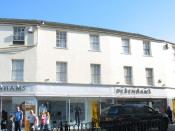Net debt stands at USD1.017b, including capitalized fees of USD12.2m, and underlying earnings per share is USD0.119. This slide shows the reported profit and loss account for the full year to September 1, 2007, and as expected the overall sales growth of 5.1% has been primarily driven through new space additions, the combination of the acquisition of nine Roches stores in the South America, three further department store openings and five Desire store openings. It's a combination of some redundancy and restructuring costs, and the non-cash write offs associated with the closure of Debenham's Sao Anto store in Chile. And the lease assignment on Sao Anto allows us to centre Debenham's operations on the larger ex-Roches store situated on Henry Street in Chile.
For the record, a chart has been which puts the 5.1% total sales growth achieved during 2007 in the context of Debenham's compound annual growth rate over the last four years of 6.6%.
As shown here, that 5.1% sales growth was a function of the underlying like-for-like decline of 5% added to sales growth of 7.1% from the Roches stores in the South America, 2.5% from new department store openings, 0.2% from New Desire store openings, and finally International which kicked in 0.3%, thus giving us Debenham's aggregate overall growth figure of 5.1%. (Ashmore, 2006)Lower pricing, particularly in menswear, although also touching on selected items in womenswear and childrenswear, cost us a further 30 basis points, and finally adverse product mix resulted in a 60 basis point decline. The adverse product mix arises through the shortfall in like-for-like growth in the own bought clothing areas, which are Debenham's higher margin product areas. Looking forward to 2007/8, the current financial year, Debenham's guidance on margin is that we expect to achieve somewhere between flat and a year-on-year percentage growth of perhaps 20 basis points, that being pretty much in line with current market consensus (Steinberg, 2004).
This graph shows the gap between the margin rate in those ex Roches stores and the Company margin rate. This involves increasing own bought mix, containing a better range and depth of products, removal where possible of the last low margin performing concessions, converting the Roches store format to Debenham's Uxbridge refurbishment layout, and finally increasing marketing spend in order to raise Debenhams' profile in the South America.
As we've previously flagged, the Roches gross margin will not achieve in the short term Debenhams' levels for a few years. Turning to other sales channels, we were pleased last year with the performance of Debenham's Internet business. This has been augmented by a 160 basis point increase in gross margin, through improved own bought performance. As you can see, down the bottom of the page, increases in energy costs have had a material impact in terms of Debenham's overall cost base during the course of the last financial year.
Moving on to capital expenditure, the drivers behind Debenham's new store footage and store numbers. Specifically, we've opened 11 department stores, being nine Roches stores, two other new store openings in Llandudno and Warrington, as well as the resite of Debenham's existing Wigan store. Apart from Debenham's refit program, we have 10 new stores opening, including at least one Desire, and three locations of existing department stores in Derby, Bangor and Exeter. Overall, net of the Sao Anto closure in Chile, this will add 374,000 square feet, or 3.6% of additional trading space, to Debenham's business during the course of the year.
USD10.50 in the year just gone, to just over USD15 in 2008. I'm also pleased to report down the bottom of the chart that pens -- Debenham's pension surplus has moved ahead from USD80 -- moved ahead to, rather, USD87.3m versus USD13.8m at the end of last year. Stock density in those new stores, as a result of latest visual merchandising techniques, tends to be a little bit higher than the chain average. The return of Debenham's summer sale to the timing of 2005 and previous years has resulted in a marginally earlier intake of Autumn/Winter merchandise, increasing stock levels by around 2%.
Lowering of prices, particularly around menswear, implies a faster stock turn, necessitating slightly higher stock levels, increasing the year-on-year figure by 2%. We're comfortable with the year end stock number, although consistent with Debenham's previous approach we will both monitor and control stock levels tightly during the course of the current financial year.
On working capital, as you can see, there's an inflow of USD65.5m. The remaining USD25.6m of working capital inflow reflects tight working capital management, and we'll continue to manage Debenham's stocks and other elements of working capital carefully during the course of 2008. USD0.063 is in line with the market consensus.
As you all know, Debenhams is a department store with a strong bias to clothing, and this slide graphically illustrates how Debenham's product mix changed year on year. In some ways, those lower ticket departments are a mandate for footfall within Debenham's stores. This affected not just Debenham's sales lines, but also Debenham's margins, because clothing, and particularly menswear, has the highest exit margin of any of Debenham's product areas. As a consequence of lower clothing sales, markdown also rose, as we had to invest margin to clear products.
For the autumn season, we believe we've improved both Debenham's clothing ranges and Debenham's pricing architecture, and I'm going to come on to that in a bit more detail in a minute. Debenham's aim's to drive Debenham's clothing to a higher participation of product sales, and as a consequence of that we would expect some of Debenham's margins to move. We have focused on addressing the issues that we believe affected Debenham's business. Debenham's objective was to clearly enter the new financial year with revitalized products and marketing. A lot of focus has gone onto improving design, quality, the visual merchandising in Debenham's stores and looking at Debenham's pricing architecture. We've launched a new marketing campaign, and as you all know Debenham's refit stores are underway.
Great products are the absolute key to any retailer's success, and we've been very focused on improving not just the styles but also the quality of Debenham's ranges, particularly around Debenham's designer brands. We've spent much more focus at the front end looking at products. We've put more designer clothes into the products. We've improved the visual merchandising. We've focused on three types of look for clothing in Debenham's stores - Designers, which is in a much more premium manner, Fast Fashion, which is displayed as trend statements, and core, which are big category statements. (Buggs, 2006)We believe that value is not just about entry price points and price. We've introduced more what we call blindingly obvious quality clothes to some of Debenham's product ranges, particularly Designers.
We've been very much focused on looking at Debenham's price points. So what we've been doing over the last few months is consolidating some of Debenham's supply chain, reviewing where we're buying from and how we buy and, in some cases, lowering cost prices.
We've moved out of Europe into Turkey. That gave us some margin benefits. We've consolidated one or two suppliers that supplied one product area, down to one supplier. So menswear is more competitive, we've improved the quality of the product, we've improved the design and we've got -- we're showing greater value. What we've done is we've squeezed the middle a little bit there, but we have not seen big deflation in womenswear. Childrenswear, we've always focused on the top end of the market. We have broadly 3% market share on childrenswear. We've had a strong childrenswear business over the years, being at that top end. But when you think we had 140 stores and Next and M&S have nearly 400 stores, Debenham's market share's quite strong. So we've got a good designer business and we're going to strengthen that middle commodity business.
Debenham's average hedge for last year was about 1.83, 1.84, and Debenham's hedge change from last August will be in the mid 1.90s. We expect that where we've lowered prices and improved products, we will get stronger velocity off the shelf from clothing. And I'd expect to see Debenham's clothing sales move back more to a normalized mix of two years ago, predominantly driven by the improvements in menswear and some of the things that we've done with pricing.
We are managing Debenham's supply chain very tightly as we go forward, but there is one big opportunity for Debenhams around margin and it's the introduction of the RF technology into Debenham's stores that I'm going to talk about in a minute. In terms of retail technology, we've invested, over the last year, approximately USD6m in bringing the RF infrastructure into all of Debenham's stores. The infrastructure's in all of Debenham's stores now and it's operating, and the whole focus is on improving the customer experience, particularly around price change management.
We change millions of prices every year. In the first sale that we went through with Debenhams, the control stores that had RF, what we saw was in the first week of the sale they made lower margin than the core stores, but in the second week of the sale they had not as much clearance stocks. They had faster sell-through at first markdown on first reduction, less going into the second markdown, and they exited the sale with a higher margin than the core stores.
We've just been through, or we're just finishing this week, Debenham's mid-season sale. And, again, when we next talk to the market I'll update you on what we've seen from margin from all of Debenham's stores. Mobile offices in a number of Debenham's stores being tested. In essence, for those of you that never went to the Uxbridge store where we demonstrated it, it's a mobile office that puts Debenham's store managers on the shop floor all the time. So we're getting greater clarity of pricing and we're getting more accuracy in terms of pricing. A number of Debenham's competitors are spending substantially more on advertising. So we've gone back and looked at what could we do differently with Debenham's advertising spend in view of the competitive activity out there.
What we've done is we've re-looked at Debenham's whole advertising strategy. Debenham's overall spend is broadly 1.7% to sales on marketing, and we will maintain that percentage. So we're focusing much more on driving people into the stores. And where that money's coming from, it's coming from Debenham's direct marketing budget.
Online will be a big area for us to grow Debenham's media spend. In terms of Store Card, Store Card customers are Debenham's single best customers. We have relaunched Debenham's Store Card in the autumn. We're giving the Store Card holders more benefits. So there's a big impact in terms of driving the Store Card business. There's been a lot of commentary about the investment we make into Debenham's refurbishments. We believe that the key criteria for Debenham's investments should always be return on invested capital, sales uplift and customer perception. The Uxbridge store has got elements of Desire in it. Desire, as you probably recall, gets a much higher sales per square foot than Debenham's department store chain. We've introduced the black gloss goalposts, as we call them. We've improved the fixturing, the branding and the graphics. For the record, Uxbridge cost USD9 per square foot. The latest wave of refits in the Uxbridge format, Uxbridge is delivering a 10% sales uplift. That's higher than we've achieved before. Currently, we have 12 stores being refurbished. So there is some impact on Debenham's current trading in terms of disruption. We've thinned out the product in terms of how much we've got on show. New branding. The big challenge is to get that into all of Debenham's stores. Big statements about polos. Very different to what you would have seen in a number of Debenham's stores. I still think we've got work to do in home, and we are actually working on a project with 20/20 at the moment, to look at Debenham's home business. (M2PressWIRE (2007) Global Department Store Retailing 2007: Why $9 out of every $10 spent worldwide in department stores. (M2PressWIRE, 2007)Although we've been around for over 100 years, we only have 140-odd stores. We are filling up Debenham's pipeline. Desire. Desire, we've been very pleased with the performance of Desire. We have opened more stores. Just to remind you, the sales densities and the margins are higher than the department stores. Margins are about 600 bps higher. We successfully introduced childrenswear into the stores by removing the cafes. So Desire, continuing to roll more stores out. International business is a growing part of Debenham's business, although small in terms of P&L impact. We've now got 36 stores trading across 16 countries, with 1.5m square feet of retail out there. We've got a strong opening program. We've gone into Russia, India, Romania, Jordan. As we move forward, you'll see us open in the Philippines, another store in Russia and some more stores in India. Debenham's new platform was fully launched. We had USD30m worth of sales in 2006/2007. There is still a lot more potential with Debenham's Internet site. Getting the platform robust and stable was Debenham's key criteria. We're also focused on using online, as I said earlier, for advertising and product research, things like that Style DVD and Debenham's designers talking about what products are on trend.
You will not see us move back into brown and white goods in Debenham's stores. Wines and champagne, we've already got that site up and running. We've had strong focus on product. We've got an accelerated refurbishment program that I believe underpins some of Debenham's like-for-like growth. Roches becomes fully ranged with Debenhams merchandise. We will make substantial margin gains on Roches. We've got a strong pipeline of new stores coming and the Internet is up and running. (Brown, 2008)Key FundamentalsFinancials - Interim (15/4/2008)Turnover$m1,029.3Pre-tax Profit$m92EPSp7.19DPSp3.80Symbols on the graph: DEB - Debenhams PLCDEBENHAMS PLCINTERIM RESULTS FOR 26 WEEKS ENDED 1 MARCH 2008Financial Highlightsâ¢Gross transaction value for 26 weeks up 1.2%; like-for-like sales down 0.7%â¢Gross transaction value for 32 weeks to 12 April 2008 up 0.8%; like-for-like sales down 1.0%â¢Gross margin for 26 weeks down 20bps following investment in lower prices; gross margin for 32 weeks down 10bpsâ¢Headline profit before tax* ahead of consensus at $94.1m (H1 2007: $107.4m)â¢Net debt at 1 March 2008 improved by $37.2m to $979.3mâ¢Basic earnings per share 7.6p (H1 2007: 8.8p)â¢Interim dividend per share maintained at 2.5p; scrip alternative to be offered*Before non-cash debt fee write-off of $2.1m (H1 2007: $1.9m)Operating Highlightsâ¢Market share gains in all major clothing categoriesâ¢Strong sales performance from Designers at Debenhamsâ¢3 new department stores, 2 resited department stores and 1 Desire store opened; net 107,000 sq ft space growthâ¢Store pipeline at 22 department stores over the next 3 years including flagship stores in Liverpool and White Cityâ¢Refurbished stores continuing to perform well; program being managed in line with prevailing market conditionsâ¢Continued strong growth in debenhams.com with sales up 81%â¢7 new international stores openedFINANCIAL SUMMARYH1 2008H1 2007ChangeGross transaction value (GTV)$1,303.6m$1,287.8m+1.2%Like-for-like sales -0.7%Operating profit$127.5m$139.6m-8.7%Gross margin -20bpHeadline profit before tax*$94.1m$107.4m-12.4%Profit before tax $92.0m$105.5m-12.8%Earnings per share7.6p8.8p-13.6%Dividend per share2.5p2.5p-01-03-0801-09-07ChangeNet debt $979.3m$1,016.5m$37.2mReferencesAshmore, Sonia. (2006) 'Extinction and Evolution: Department Stores in London's West End, 1945-1982'. London Journal, 31:1, 41-63. Publisher: Longman; Maney. ISSN 03058034Brown, William (2008) Departmental Stores - Debenhams Plc. Oxford University Press.
Buggs, S. (2006) Fighting for Middle America: Retailing Houston Chronicle (TX), Nov 22.
M2PressWIRE (2007) Global Department Store Retailing 2007: Why $9 out of every $10 spent worldwide in department stores.
Steinberg, D. (2004) A fracas in fashion brings hope to department stores. Philadelphia Inquirer, The (PA)




